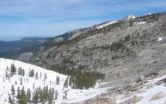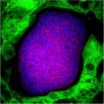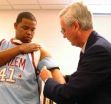(Press-News.org) Results of a new study tie forest "greenness" in the western United States to fluctuating year-to-year snowpack extent.
The results show that mid-elevation mountain ecosystems are the most sensitive to rising temperatures and to changes in precipitation and snowmelt.
University of Colorado-Boulder scientist Noah Molotch and colleagues used satellite images and ground measurements to identify the threshold at which mid-level forests sustained by moisture change to higher-elevation forests sustained by sunlight.
A paper reporting the results was published yesterday in the journal Nature Geoscience.
Molotch is the lead author. Co-authors are Ernesto Trujillo of the University of Colorado-Boulder and Ecole Polytechnique Fédérale de Lausanne in Switzerland; Michael Golden and Anne Kelly of the University of California, Irvine; and Roger Bales of the University of California, Merced.
"The research demonstrates yet another complexity in the response of mountain ecosystems to increasing temperatures," says hydrologist Tom Torgersen, program director in the National Science Foundation's Division of Earth Sciences, which funded the research. "High-elevation mountain forests are typically temperature-stressed and low-elevation mountain forests are often water-stressed.
"At mid-elevations, 'everything is just right'--until it goes wrong." Torgersen says, "Higher temperatures lead to reduced snowpack and reduced water availability, leaving trees at mid-elevations more stressed and more prone to fires."
The ability to identify this "tipping point" is important, Molotch says, because mid-level forests--at altitudes from roughly 6,500 feet to 8,000 feet--are where many people live and visit. They're also linked with increasing wildfires, beetle outbreaks and rising tree mortality.
"These results provide the first direct observations of snowpack-forest connections across broad scales," says Molotch.
"Finding the tipping point between water-limited [mid-elevation] forests and energy-limited [high-elevation] forests defines the region of the greatest sensitivity to climate change--the mid-elevation forests--which is where we should focus future research," he says.
Although the research took place in the Sierra Nevada mountain range in California, it's applicable to other mountain ranges across the West.
Climate studies show that the snowpack in mid-elevation forests in the western United States and other forests around the world has been decreasing over the past 50 years because of regional warming.
"We found that mid-elevation forests show a dramatic sensitivity to snow that fell the previous winter in terms of accumulation and subsequent melt," said Molotch, also a scientist at NASA's Jet Propulsion Laboratory in Pasadena.
"If snowpack declines, forests become more stressed, which can lead to ecological changes in the distribution and abundance of plant and animal species, and to more vulnerability to fires and to beetle kill."
Molotch says that about 50 percent of the greenness seen by satellites in mid-elevation forests is linked with maximum snow accumulation from the previous winter, with the other 50 percent related to soil depth, soil nutrients, temperature and sunlight.
"The strength of the relationship between forest greenness and snowpack from the previous year is very surprising," Molotch says.
The researchers initially set out to identify the various components of drought that lead to vegetation stress.
"We went after mountain snowpacks in the western U.S. because they provide about 60 to 80 percent of the water in high-elevation mountains," says Molotch.
The team used 26 years of continuous data from the Advanced Very High Resolution Radiometer, a space-borne sensor flying on a National Oceanic and Atmospheric Administration satellite, to measure the forest greenness.
The researchers compared it with long-term data from 117 snow stations maintained by the California Cooperative Snow Survey, a consortium of state and federal agencies.
In addition, the scientists used information gathered from "flux towers" in the southern Sierra Nevada mountain range. Instruments on these towers measure the exchanges of carbon dioxide, water vapor and energy between the land and the atmosphere.
Instruments on the towers, which are some 100 feet high, allowed scientists to measure the sensitivity of both mid-level and high-level mountainous regions to both wet and dry years--data that matched up well with the satellite and ground data.
"The implications of this study are profound when you think about the potential for ecological change in mountain environments in the West," says Molotch.
"If we look ahead to the time when climate models are calling for warming and drying conditions, the implication is that forests will be increasingly water-stressed in the future and more vulnerable to fires and insect outbreaks."
In the context of recent forest losses to fire in Colorado and elsewhere, the findings are something that really deserve attention, Molotch says.
"This tipping-point elevation is very likely going to migrate up the mountainsides as climate warms."
INFORMATION:
The research was also funded by NASA.
-NSF-
Study ties forest 'greenness' in western US to snowpack extent
Mid-elevation mountain ecosystems most sensitive to rising temperatures and changes in snowmelt
2012-09-11
ELSE PRESS RELEASES FROM THIS DATE:
NASA catches Tropical Storm Leslie and Hurricane Michael in the Atlantic
2012-09-11
Satellite images from two NASA satellites were combined to create a full picture of Tropical Storm Leslie and Hurricane Michael spinning in the Atlantic Ocean. Imagery from NASA's Aqua and Terra satellites showed Leslie now past Bermuda and Michael in the north central Atlantic, and Leslie is much larger than the smaller, more powerful Michael.
Images of each storm were taken by the Moderate Resolution Imaging Spectroradiometer, or MODIS instrument that flies onboard both the Aqua and Terra satellites. Both satellites captured images of both storms on Sept. 7 and Sept. ...
'Humanized' mice developed at OHSU enable malaria research breakthrough at Seattle BioMed
2012-09-11
PORTLAND, Ore. — A novel human liver-chimeric mouse model developed at Oregon Health & Science University and Yecuris Corporation has made possible a research breakthrough at Seattle Biomedical Research Institute that will greatly accelerate studies of the most lethal forms of human malaria.
The study findings are published online in the Journal of Clinical Investigation. Study photos were selected to appear in "Scientific Show Stoppers" on the JCI blog.
Plasmodium falciparum, one of two human-specific malaria parasites, is a global health crisis, causing more than ...
Mushroom-derived compound lengthens survival in dogs with cancer, Penn Vet study finds
2012-09-11
PHILADELPHIA — Dogs with hemangiosarcoma that were treated with a compound derived from the Coriolus versicolor mushroom had the longest survival times ever reported for dogs with the disease. These promising findings offer hope that the compound may one day offer cancer patients — human and canine alike — a viable alternative or complementary treatment to traditional chemotherapies.
The study was conducted by two University of Pennsylvania School of Veterinary Medicine faculty. Dorothy Cimino Brown is professor and chair of the Department of Clinical Studies and director ...
Psychopathic boldness tied to US presidential success
2012-09-11
The fearless dominance associated with psychopathy may be an important predictor of U.S. presidential performance, suggests an analysis published this week in the Journal of Personality and Social Psychology.
"Certain psychopathic traits may be like a double-edged sword," says lead author Scott Lilienfeld, a psychologist at Emory University. "Fearless dominance, for example, may contribute to reckless criminality and violence, or to skillful leadership in the face of a crisis."
In fact, fearless dominance, linked to diminished social and physical apprehensiveness, ...
LifeSkills training helps teens manage anger, lower blood pressure
2012-09-11
AUGUSTA, Ga. – A 10-week program that fits easily into the high school curriculum could give students a lifetime of less anger and lower blood pressure, researchers report.
Health and physical education teachers taught anger and stress management to 86 ninth graders in Augusta, Ga., and found their ability to control anger increased, their anxiety decreased and their blood pressures were generally lower over the course of a day compared to 73 of their peers who received no intervention, according to a study published in the journal Translational Behavioral Medicine.
Among ...
Measuring mercury levels: Nano-velcro detects water-borne toxic metals
2012-09-11
ANN ARBOR, Mich.—A strip of glass covered in hairy nanoparticles can cheaply and conveniently measure mercury, which attacks the nervous system, and other toxic metals in fluids.
Researchers at the Swiss Federal Institute of Technology (EPFL), Northwestern University and the University of Michigan found that their new method can measure methyl mercury, the most common form of mercury pollution, at unprecedentedly small concentrations. The system, which could test for metal toxins in drinking water and fish, is reported in the current edition of Nature Materials.
Methyl ...
University of Maryland study: Neonatal heart stem cells may help mend kids' broken hearts
2012-09-11
Baltimore, MD – September 10, 2012 – Researchers at the University of Maryland School of Medicine, who are exploring novel ways to treat serious heart problems in children, have conducted the first direct comparison of the regenerative abilities of neonatal and adult-derived human cardiac stem cells. Among their findings: cardiac stem cells (CSCs) from newborns have a three-fold ability to restore heart function to nearly normal levels compared with adult CSCs. Further, in animal models of heart attack, hearts treated with neonatal stem cells pumped stronger than those ...
Expanding database enables discoveries in emerging field of metabolomics
2012-09-11
LA JOLLA, CA – September 10, 2012 – Over the last decade, metabolomics has emerged as the newest of the "omic" sciences (following genomics and proteomics) to provide comprehensive biochemical information about cellular metabolism. This new field has revealed that many of the chemicals involved in or produced through metabolism are currently unknown, but may play vital and previously unappreciated roles in human health and disease.
A major hurdle in profiling both unknown and known metabolic compounds ("metabolites") has been the scarce amount of reference data. But ...
Researchers closer to understanding actions of cells involved in atherosclerosis
2012-09-11
TORONTO, Sept. 10, 2012—Researchers at St. Michael's Hospital are one step closer to understanding why plaque bursts in coronary arteries and causes heart attacks.
The clue might be something called microRNA-145. MicroRNAs are short chains of bossy molecules that scientists are increasingly coming to realize control a wide variety of biological processes.
Dr. Subodh Verma, a cardiac surgeon at St. Michael's, published a paper in the journal Circulation today, describing for the first time how microRNA-145 gene therapy can drastically reduce the severity and progression ...
ORNL roof and attic design proves efficient in summer and winter
2012-09-11
A new kind of roof-and-attic system field-tested at the Department of Energy's Oak Ridge National Laboratory keeps homes cool in summer and prevents heat loss in winter, a multi-seasonal efficiency uncommon in roof and attic design.
The system improves efficiency using controls for radiation, convection and insulation, including a passive ventilation system that pulls air from the underbelly of the attic into an inclined air space above the roof.
"Heat that would have gone into the house is carried up and out," says Bill Miller of ORNL's Building Envelope Group. "And ...
LAST 30 PRESS RELEASES:
Making lighter work of calculating fluid and heat flow
Normalizing blood sugar can halve heart attack risk
Lowering blood sugar cuts heart attack risk in people with prediabetes
Study links genetic variants to risk of blinding eye disease in premature infants
Non-opioid ‘pain sponge’ therapy halts cartilage degeneration and relieves chronic pain
AI can pick up cultural values by mimicking how kids learn
China’s ecological redlines offer fast track to 30 x 30 global conservation goal
Invisible indoor threats: emerging household contaminants and their growing risks to human health
Adding antibody treatment to chemo boosts outcomes for children with rare cancer
Germline pathogenic variants among women without a history of breast cancer
Tanning beds triple melanoma risk, potentially causing broad DNA damage
Unique bond identified as key to viral infection speed
Indoor tanning makes youthful skin much older on a genetic level
Mouse model sheds new light on the causes and potential solutions to human GI problems linked to muscular dystrophy
The Journal of Nuclear Medicine ahead-of-print tip sheet: December 12, 2025
Smarter tools for peering into the microscopic world
Applications open for funding to conduct research in the Kinsey Institute archives
Global measure underestimates the severity of food insecurity
Child survivors of critical illness are missing out on timely follow up care
Risk-based vs annual breast cancer screening / the WISDOM randomized clinical trial
University of Toronto launches Electric Vehicle Innovation Ontario to accelerate advanced EV technologies and build Canada’s innovation advantage
Early relapse predicts poor outcomes in aggressive blood cancer
American College of Lifestyle Medicine applauds two CMS models aligned with lifestyle medicine practice and reimbursement
Clinical trial finds cannabis use not a barrier to quitting nicotine vaping
Supplemental nutrition assistance program policies and food insecurity
Switching immune cells to “night mode” could limit damage after a heart attack, study suggests
URI-based Global RIghts Project report spotlights continued troubling trends in worldwide inhumane treatment
Neutrophils are less aggressive at night, explaining why nighttime heart attacks cause less damage than daytime events
Menopausal hormone therapy may not pose breast cancer risk for women with BRCA mutations
Mobile health tool may improve quality of life for adolescent and young adult breast cancer survivors
[Press-News.org] Study ties forest 'greenness' in western US to snowpack extentMid-elevation mountain ecosystems most sensitive to rising temperatures and changes in snowmelt



